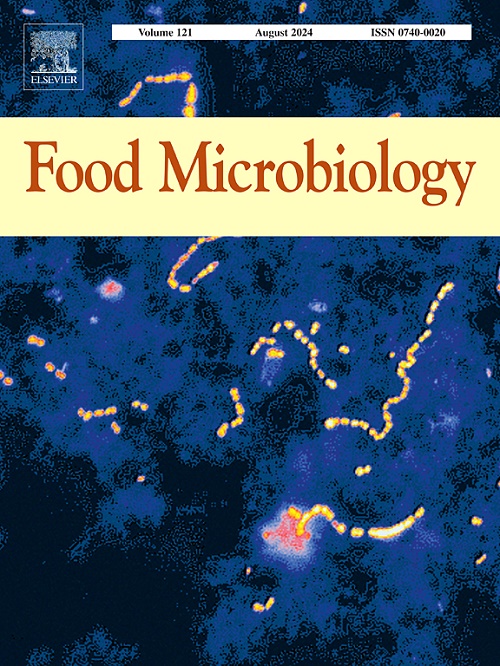AHLs-driven quorum sensing modulates competitive interspecies interactions in synthetic biofilms community among fish spoilage bacteria
IF 4.5
1区 农林科学
Q1 BIOTECHNOLOGY & APPLIED MICROBIOLOGY
引用次数: 0
Abstract
Food spoilage microorganisms often reside in dense mixed-species biofilms mediated by quorum sensing (QS). However, the regulatory mechanisms underlying interspecific interactions within spoilage microecosystems remain poorly understood. In this study, an experimental mixed-species biofilms model consisting of Pseudomonas fluorescens, Shewanella baltica, and Acinetobacter johnsonii was established to examine interspecies interactions at different temperatures and to explore regulatory role of N-acyl-L-homoserine lactones (AHLs). Genome sequencing revealed that compared to only LuxR receptor in S. baltica and A. johnsonii, P. fluorescens possesses a complete LuxI/R-type QS system and numerous genes related to biofilms formation and iron acquisition. Phenotypic results confirmed that P. fluorescens, as the dominant strain in the mixed-species biofilms, enhanced its competitiveness at low temperatures by repressing S. baltica metabolism. Meanwhile, S. baltica and A. johnsonii could eavesdrop on AHLs signaling secreted by P. fluorescens, particularly C4-HSL. C4-HSL-mediated QS modulated interspecies competition within the biofilms community and contribute to increased disinfectant resistance, likely through enhanced antioxidant capacity. Transcriptomic analysis revealed that C4-HSL activated multiple genes expression involved in oxidative stress defense to mitigate intracellular ROS accumulation, including antioxidant enzyme synthesis, pyoverdine production for iron chelation and competitive advantage, and the upregulating ABC transporters and two-component systems to facilitate substance transport. Thus, these findings demonstrate that AHL-mediated interspecies communication plays a critical role in maintaining biofilms stability and provide mechanistic insights into QS-driven bacterial adaptation, offering potential strategies for targeted biofilms control.
ahls驱动的群体感应调节鱼类腐败菌合成生物膜群落中竞争性种间相互作用
食品腐败微生物通常存在于由群体感应(quorum sensing, QS)介导的密集混合种生物膜中。然而,腐败微生态系统中种间相互作用的调控机制仍然知之甚少。本研究建立了由荧光假单胞菌、波罗的海希瓦氏菌和约氏不动杆菌组成的实验混合种生物膜模型,研究了不同温度下种间的相互作用,并探讨了n -酰基- l-同丝氨酸内酯(AHLs)的调节作用。基因组测序结果显示,相较于波罗的海链球菌和约翰氏单胞杆菌,P. fluorescens具有完整的LuxI/ r型QS系统和大量与生物膜形成和铁获取相关的基因。表型结果证实,P. fluorescens作为混合种生物膜中的优势菌株,通过抑制S. baltica的代谢来增强其低温竞争力。同时,S. baltica和A. johnsonii可以窃听P. fluorescens分泌的ahl信号,特别是C4-HSL。c4 - hsl介导的QS调节了生物膜群落内的种间竞争,并可能通过增强抗氧化能力来增强对消毒剂的抵抗力。转录组学分析显示,C4-HSL激活了参与氧化应激防御的多个基因表达,以减轻细胞内ROS的积累,包括抗氧化酶合成、铁螯合和竞争优势的pyoverdine生产,以及促进物质运输的ABC转运蛋白和双组分系统的上调。因此,这些发现表明,ahl介导的种间通讯在维持生物膜稳定性中起着关键作用,并为qs驱动的细菌适应提供了机制见解,为靶向生物膜控制提供了潜在的策略。
本文章由计算机程序翻译,如有差异,请以英文原文为准。
求助全文
约1分钟内获得全文
求助全文
来源期刊

Food microbiology
工程技术-生物工程与应用微生物
CiteScore
11.30
自引率
3.80%
发文量
179
审稿时长
44 days
期刊介绍:
Food Microbiology publishes original research articles, short communications, review papers, letters, news items and book reviews dealing with all aspects of the microbiology of foods. The editors aim to publish manuscripts of the highest quality which are both relevant and applicable to the broad field covered by the journal. Studies must be novel, have a clear connection to food microbiology, and be of general interest to the international community of food microbiologists. The editors make every effort to ensure rapid and fair reviews, resulting in timely publication of accepted manuscripts.
 求助内容:
求助内容: 应助结果提醒方式:
应助结果提醒方式:


